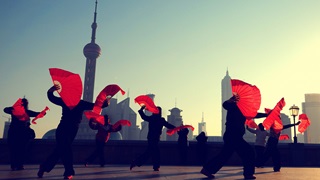
The historian
On Shanghai as a metamorphic rock| Issue 20 | 2022


—Reports filed by correspondents across the world—
This year, we almost missed it entirely. Restless after Thanksgiving dinner, I checked the weather and, seeing that the unseasonable warmth would continue, proposed a family hike the next day. It was not until the plans were made that I connected the dots—we were accidentally continuing a family tradition.
In the U.S., the day after Thanksgiving is Black Friday. During my lifetime this has been, by force of tradition and retail conspiracy, when Christmas shopping begins in earnest. But even before the pandemic, Black Friday’s significance has waned—a victim of its own success, imitators from Small Business Saturday, Cyber Monday, and Amazon’s Prime Day have crowded the field.
This particular Thanksgiving came as the highest COVID-19 infection rates in the world were concentrated here in the American Midwest. State and local government and health officials urged everyone to stay home and avoid indoor gatherings—hollowing out a holiday based on gathering extended family and friends around the table.
Because Thanksgiving was barely happening, we had given no thought to Black Friday. For the past few years, we had marked the day with a family hike. Even this, spending the day outside instead of shopping, is now promoted as a counter tradition to Black Friday.
We moved recently, so we tried a new park this year: Lebanon Hills. It’s a large suburban park dominated by rolling hills, spotted with lakes and ponds ringed by sparse trees. Like a lot of parks on the outskirts of Minneapolis, it is networked with trails posted for a variety of seasonal uses, hiking, skiing, snowshoeing, horse riding, and mountain biking. On a sunny Fall day with no snow on the ground, all of the paths were being used by people for walking. Most wore masks, but not all. Masked or not, almost everyone was visibly uncomfortable as we approached, with the forced smile and stiff posture of someone holding a screaming infant on an airplane. I am sure we were no different.
Just off a ski trail, we found a pond capped with a thin layer of ice. Only a strip of water remained around the shore. My boys, with pockets filled for just such an opportunity, threw rocks, hoping they would crash through the ice. Instead, the rocks bounced, each impact making an astonishing sound, like bursts from a ray gun in a 1960s sci-fi movie. I never heard anything like it before. I am glad we did not miss it.
In the midst of the second wave of Covid-19, an American mini-series, The Queen’s Gambit, has distracted everyone from yet more talk of the pandemic and has become a feature of much discussion on the Russian internet. The series is based on the same-name novel written in 1983 by Walter Tevis. It tells the story of a young American female chess player who has been through numerous hardships, including the loss of her mother in her early years and the subsequent loss of a guardian, life in an orphanage, and addiction to medical drugs and alcohol. Why did this have such strong resonance for Russians? That is, aside from the undisputed talents of its creators and the charisma of the good-looking actress-star? There are a number of reasons.
State childcare institutions—be it five-day kindergartens or month-long pioneer camps—were an integral part to the life story of every Soviet child. Thus, from the first opening minutes of The Queen’s Gambit, you are emotionally attached. You feel compassion for this little girl, who finds herself in an orphanage and has to adapt to the strict, unemotional atmosphere of a far-from-a-family society.
The series is full of allusions to well-known textbook characters. One viewer identifies Lolita in Elisabeth Harmon’s protagonist, another finds direct references to Nabokov’s The Luzhin Defence. For me, the story of a little girl from nowhere becoming a world chess champion is a replaying of the story of Alice, who steps through the looking glass to become, at the end of the game, the White Queen.
But the main reason for the popularity of this series in Russia is, of course, the game itself. Chess was incredibly popular in Soviet Russia. I remember a Soviet TV show in the 1970s where the basic chess combinations were studied throughout an hour-long prime-time TV broadcast. Every library, rest hall and lounge area was equipped with chess, from tiny figurines to towering figures scaled up to human size.
In the last episodes of The Queen’s Gambit, the heroine comes to Russia. This is where she feels herself a real star. A striking contrast: from being known only to a weird circle of chess professionals in America, in the Soviet Union, where the whole population followed every move of a prominent chess game, she is lauded as the true People’s Favourite.
Many Russian viewers criticized the wrongful depiction of the streets and buildings of Moscow—but this is not important. What is important, much more important, is the Marvel-style atmosphere of Soviet Russia with authentically reproduced wooden-velvet interiors, high ceilings and a gloomy monumentalism: all of it true and very close to my childhood memories.
At the start of the year, as the epidemic became a pandemic, Shanghai became a city of deserted streets and empty metro.
Almost eight months later, I arrived in the city. My wife, who is Chinese, was starting a new position, and I was accompanying her. We were taken immediately into strict solitary isolation in a government-requisitioned hotel. Everyone—from the moment our flight landed to the moment we left the room—everyone we interacted with was decked out in a white biohazard suit. We were tested for Covid-19 as we arrived at the airport and again before we left the hotel. Fourteen days later, we were released into a city of 24 million people that is, to all intents and purposes, Covid-free.
No social distancing. No lockdown. Restaurants, shops, bars, public spaces, galleries, schools, universities: they are all open and buzzing. The streets and metro are full of jockeying bodies, from business-suited commuters to migrant workers. Building sites are teeming with life, as projects that had been put on hold race to meet untold deadlines. Life looks normal.
But not so. There is more the sense of treading around the tail of a dragon. And people are willing to tread carefully, lest the head wake up. I am writing this in a reading room in the Shanghai Library, entry to which required a QR code generated from my green health QR code (my passport to everywhere) plus sight of my actual passport. Not so long ago, we went to see Lady of the Camellias at the Shanghai International Dance Center. Getting tickets required a national ID (or in our case, a passport) and phone numbers. Tickets were hand-delivered and signed for. Getting into the Center took an updated green health code, a temperature check, and, of course, a face mask.
I found my way to the tailors’ haunt, the ‘fake market’, home to at least a hundred tailors. Well-dressed headless manikins lined the maze of corridors, and my own image came and went as I passed by full-length mirrors. Sales assistants were flopped against their seats, watching TV, or idly talking, or simply chilling. Business, along with the tourists, has essentially vanished. I began my bargaining patter but it did not take long to agree a price, ‘because you are my only customer today’.
In late November, two people, then five more, were discovered to have Covid. Thousands were immediately tested and isolated, half of all incoming flights were cancelled, schools took their ‘ready to close’ procedures to the next level, and temperature checks became even more widespread. Shanghai is Covid-free, and Covid-ready.
Leaf McGregor is a lawyer based in Minneapolis. Natalia Mushinska is RE:’s Moscow correspondent. Dr Mike Ellis is a guest stringer.
© Norton Rose Fulbright LLP 2025